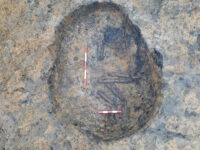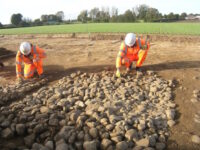
Interestingly, the round barrow was constructed very close to, but not over, what archaeologists call a ‘burnt mound’. These enigmatic prehistoric sites are relatively common in upland areas where they survive as mounds of burnt stone and charcoal, but the lowland examples are less obvious due to being flattened by later ploughing. Little is known about what burnt mounds were used for, and their excavation is seen as an important research priority. […]
Previous excavations of similar sites in the UK and Ireland have shown that water was an important part of the process with water troughs lined with wood or clay being discovered. Other sites include earth-ovens or roasting pits and the combined evidence has led to several theories about what activities were carried out. The main theory is that stones were heated up and placed in the troughs to heat water, either during the process of dyeing cloth or cooking. Alternatively, some burnt mound sites include structures that could have been used as saunas.

A small earth oven and a deep pit believed to have been a well were also found near the barrow. Heating stones were left in the oven from its last use and soil samples will be analyzed for traces of what might have been cooked there. The bottom of the well was still waterlogged, preserving part of its prehistoric wooden lining, a particularly exciting find. The waterlogged fill at the bottom of the well will also be sampled and analyzed for plant, animal and insect remains.
* This article was originally published here








No comments:
Post a Comment